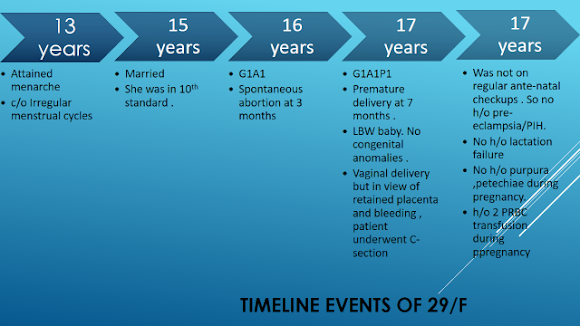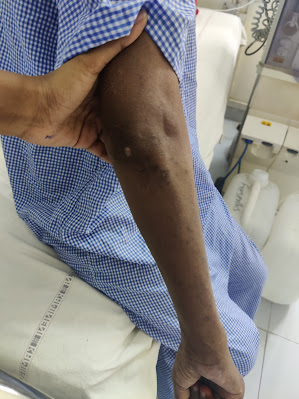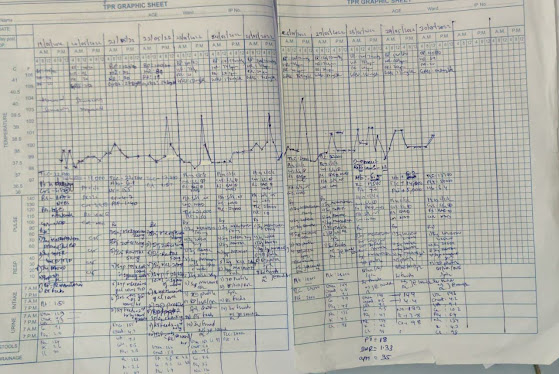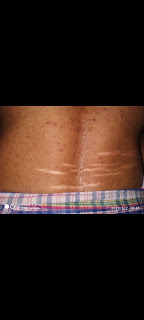LONG CASE - 19100006004
This is an online E log book to discuss our patient's de-identified health data shared after taking his/her/guardian's signed informed consent. Here we discuss our individual patient's problems through series of inputs from available global online community of experts with an aim to solve those patient's clinical problems with collective current best evidence based inputs. This E log book also reflects my patient-centered online learning portfolio and your valuable inputs on the comment box .
CASE PRESENTATION :
CHEIF COMPLAINTS :
29/F came to OPD with C/o Loss of appetite , weight since 2 years
Generalised weakness and easy fatiguability since 2 years .
C/o Fever since 6 months
C/o Multiple joint pains and swelling since 6 months
Difficulty in movements and walking since 6 months.
C/o Hyper-pigmented leisons over cheeck bones and chin ,ears , b/l fore arm since 4 months .
C/o Severe hair loss since 4 months .
HOPI AND PAST HISTORY :
NO H/o chest pain, shortness of breath ,PND.
NO H/o bluish ,white discoloration of limbs on exposure to cold .
No h/o dry eyes and dry mouth .
FAMILY HISTORY :
No family history of joint pains/ other auto-immune diseases.
Younger sister SCD .
EDUCATIONAL STATUS :
Patient completed her BA .
MARITAL HISTORY :
Married at 15 years of age . But divorced at 20 years of age.
SOCIAL HISTORY :
Poor socio-economic status .
PROVISIONAL DIAGNOSIS :
PROBLEM REPRESENTATION :
- H/o recurrent abortions , and young onset CVA , Seizures suggests ? HYPER-COAGULABLE STATE
-29/F with recurrent history of fever and multiple joint pains , rash and hair loss , loss of appetite and weight ,fatigue - all point towards auto immune etiology ,especially in a young female .
2-3 year history of bilaterally symmetrical ,chronic progressive inflammatory polyarthritis predominantly involving small joints .
Features favouring an inflammatory pathology are -
- Features of inflammation such as severe pain associated with edema of the joints and limitation of range of active movements
- Early morning stiffness, lasting for more than 30 mins (for 1 hour in this patient)
- Pain and edema of joints improving with activity and worsening with rest
- Features of uncontrolled systemic inflammation such as fever, involuntary loss of weight associated with loss of appetite.
- Swellings at joints and deformation of normal joint posture
Provisional Diagnosis - Bilaterally Symmetric Chronic Progressive Inflammatory Peripheral Polyarthritis
GENERAL EXAMINATION :
Head to Toe General Examination
Systemic Examination
Musculo-Skeletal System :
|
JOINTS |
RIGHT |
LEFT |
|
1)SHOULDER JOINT a) Inspection : Attitude of limbs –
Swelling – Skin - Deformity – Muscle wasting –
b)Palpation :
Tenderness – Warmth – Synovial thickening – Crepitus –
c) Range of movements : Active Passive
|
Slightly flexed and internally rotated; Contour
normal NO NO ERYTHEMA NO NO
All inspiratory findings confirmed YES NO NO NO
Slight limitation of active and passive extension and
overhead abduction |
Slightly flexed and internally rotated; Contour
normal NO NO ERYTHEMA NO NO
All inspiratory
findings confirmed YES NO NO NO
Slight limitation of active and passive extension
and overhead abduction |
|
2)ELBOW JOINT a) Inspection : Attitude of limbs –
Swelling – Skin - Deformity – Muscle wasting –
b)Palpation : Tenderness – Warmth – Synovial thickening – Crepitus –
c) Range of movements : Active Passive
|
Attitude - mid-flexion; alignment
of elbow and forearm - normal; YES NO erythema No No
YES SLIGHT NO NO
No restriction
|
Attitude - mid-flexion; alignment of elbow and
forearm - normal; NO NO erythema No No YES NO NO NO
No restriction
|
|
3)WRIST JOINT: a) Inspection : Attitude of limbs – Swelling – Skin - Deformity – Muscle wasting –
b)Palpation : Tenderness – Warmth – Synovial thickening – Crepitus –
c) Range of movements : Active Passive
|
MILD EXTENSION
No No No No
Yes No No No
Limitation of active and passive ulnar deviation |
MILD EXTENSION
No No No No
Yes No No No
Limitation of active and passive ulnar deviation |
|
4)HANDS (small joints) a) Inspection : Attitude of limbs – Swelling – Skin - Deformity – Muscle wasting –
b)Palpation : Tenderness – Warmth – Synovial thickening – Crepitus –
c) Range of movements : Active Passive
|
Fingers
flexed at MCP and PIP MILD NO ERYTHEMA NO NO
Present at
MCP,PIP NO NO NO
Slight Limitation
of passive flexion at MCP |
Fingers
flexed at MCP and PIP MILD NO ERYTHEMA NO NO
Present at MCP,PIP NO NO NO
Slight Limitation
of passive flexion at MCP |
|
5)HIP JOINT : a) Inspection : Attitude of limbs – Swelling – Skin - Deformity – Muscle wasting –
b)Palpation : Tenderness – Warmth – Synovial thickening – Crepitus –
c) Range of movements : Active Passive
|
Slight flexed and internal rotated NO NO erythema No No
Yes No No No
Limitation of passive and active movements of flexion and
extension. (towards
the end of range of motion); |
Slight flexed and
internal rotated NO NO erythema No No
Yes No No No
Limitation of passive and
active movements of flexion and extension( towards the end of range of
motion); |
|
6) KNEE JOINT : a) Inspection : Attitude of limbs – Swelling – Skin - Deformity – Muscle wasting –
b)Palpation : Tenderness – Warmth – Synovial thickening – Crepitus –
c) Range of movements : Active Passive
|
MILD NO erythema No No
Yes No No No
No restriction
|
MILD NO erythema No No
Yes No No No
No restriction |
|
7) ANKLE JOINT: a) Inspection : Attitude of limbs – Swelling – Skin - Deformity – Muscle wasting –
b)Palpation : Tenderness – Warmth – Synovial thickening – Crepitus –
c) Range of movements : Active Passive
|
Dorsiflexed Yes (minimal) No No No
Yes Slight No No
Limitation of passive and active plantar flexion |
Dorsiflexed Yes No No No
Yes Slight No No
Limitation of passive and active plantar flexion |
|
8) FEET EXAMINATION : a) Inspection : Attitude of limbs –
Swelling – Skin - Deformity – Muscle wasting –
b)Palpation : Tenderness – Warmth – Synovial thickening – Crepitus –
c) Range of movements : Active Passive
|
Foot hanging
on side of bed
No No No No
Yes at MTP,PIP NO No No
Limitation of passive movements of flexion and extension of
MTP joints
|
Foot hanging on side of bed
No No No No
Yes at MTP ,PIP NO No No Limitation
of passive movements of flexion and extension of MTP joints
|
|
|
|
|
|
|
|
|
Is associated with a worse prognosis and higher mortality from the disease.12,16,17 It has been linked with a severe disease course including neuropsychiatric disorders, renal involvement, hemolytic anemia and antiphospholipid syndrome.The leading cause of death in the Reveille et al.20 study was infection.In two large studies thrombocytopenia was the only independent predictor for mortality in SLE.




























Comments
Post a Comment